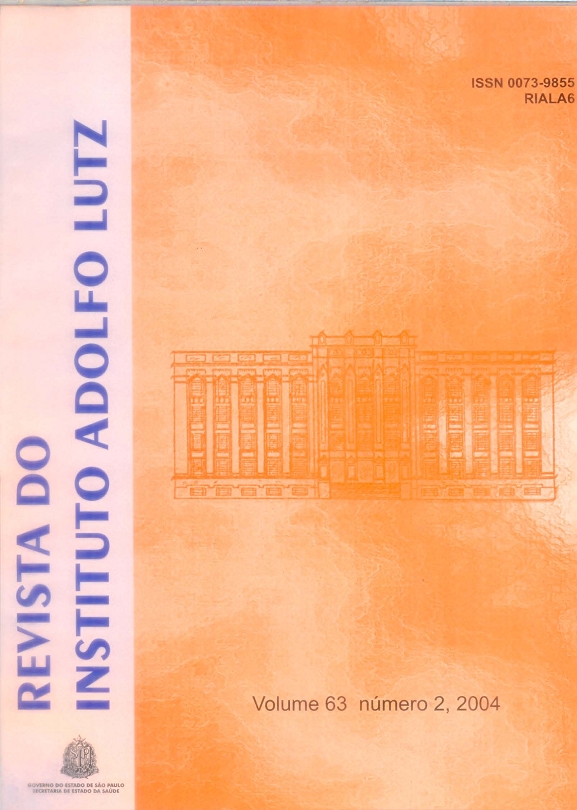Abstract
Cryptosporidium is a coccidian protozoan that causes diarrhea in human beings, domestic animals, and other vertebrates. Although cryptosporidiosis is self-limited disease in healthy individuals, patients with AIDS usually go through a prolonged life-threatening diarrhea. Cryptosporidiosis laboratory diagnosis
has been performed by means of parasite detection using parasitological, imunological, or molecular methods. In the present study 29 samples were selected, being 15 positive and 14 negative for Cryptosporidium on Kinyoun staining. All of 29 fecal samples were tested on Nested PCR (N-PCR), and 16
out 29 samples were N-PCR positive. Among these 16 N-PCR positive samples, 11 were positive on EIA and Kinyoun staining, and five were negative on both techniques. Kinyoun staining detected four positive samples though two of them were negative on N-PCR and EIA. The use of molecular method may
improve the diagnosis as the reported sensitivity and specificity rates have been higher the conventional techniques as morphology-based methods. Besides, molecular methods have lately been used to characterize the different genotype of C. parvum. Based on the data observed in the present study concerning the considerable discrepancies of results among three laboratory techniques , further investigations have to be performed
References
1. Alcântara, L. M. et al. Infecção por Cryptosporidium em crianças de creche de uma comunidade marisqueira em Encarnação de Salinas – BA. J. Bras. Parasitol. Anais -XV Congresso Latino- Americano de Parasitologia (Suppl), 94, 2001 – São Paulo – Brasil.
2. Balatbat, A. B. et al. Detection of Cryptosporidium parvum DNA in human feces by Nested PCR. J. Clin. Microbiol., 34: 1769-72, 1996.
3. Da Silva, A. J. et al. Fast and reliable extraction of protozoan parasite DNA from fecal specimes. Mol. Diagn., 4: 57-64, 1999.
4. Dean A, G. et al. Epi Info, version 6: a word processing database, and statistics program for epidemiology on microcomputer. Center of Disease Control on Prevention, Atlanta, Georgia, U.S.A, 1994.
5. De Carli, G. A. Exame macroscópico e microscópico da amostra fecal fresca e preservada. In:__ Parasitologia Clínica. São Paulo: Atheneu. 2001. p. 27-81.
6. Doing, K. M. et al. False positive results obtained with the Alexon ProSpect Cryptosporidium Enzime Immunoassay. J. Clin. Microbiol. 37: 1582-3, 1999.
7. Fleis, A. R. Clinical epidemiology. In:_ The architecture of clinical research. Philadelphia: WB Saunders. 1985, p. 185-6.
8. Gamba, R. C. et al. Detections of Cryptosporidium sp oocysts in groundwater for human consumption in Itaquaquecetuba city, São Paulo – Brazil. Braz. J. Microbiol. 31: 151-3, 2000.
9. Garcia, L. S; Shimizu, R. Y. Evaluation of nine immunoassay Kits (enzyme immunoassay and direct fluorescence) for detection of Giardia lamblia and Cryptosporidium parvum in human fecal specimens. J. Clin. Microbiol. 35: 1526-9, 1997.
10. Gatei, W. et al. Molecular analysis of the 18S rRNA gene of Cryptosporidium parasites from patients with or without humam immunodeficiency virus infections living in Kenya, Malawi, Brazil, the United Kingdom, and Vietnam. J. Clin. Microbiol., 41: 1458-62, 2003.
11. Gobet, F. et al. A detection of Cryptosporidium parvum DNA in formed human feces by a sensitive PCR- based assay including Uracil-NGlycosylase inactivation. J. Clin. Microbiol. 35: 254-6, 1977.
12. Gomes, A. H. S. et al. Monitoramento das condições higiênico sanitárias das alfaces produzidas no município de Ibiúna- SP, Brasil. [Suplemento científico, Anais XXV Congresso Latino- Americano de Parasitologia de 7 a 11 de outubro de 2001 – São Paulo – Brasil]. J. Bras. Parasitol. 37: 94, 2001.
13. Healy, G. R.; Garcia, L. S. Intestinal and Urogenital Protozoa. In: Murray, P. R.; Baron. et al. Manual of Clinical Microbiology. 6th ed. Washington (D.C) ASM Press. 106: 1204-28, 1995.
14. Ignatius, R. et al. Efficacy of different methods for detection of low Cryptosporidium parvum oocyst numbers or antigen concentrations in stool specimens- Eur. J. Clin. Microbiol. Infect. Dis. 16: 732-6, 1997.
15. Informenet- DTA. Surtos de Doenças Transmitidas por Alimentos (tabela de 1995 a 2002). Dados Estatísticos São Paulo, 2002. DDTHA/CVE-SES/SP. Available from: URL: http://www.cve.saude.sp.gov.br [cited sept 2003].
16. Johnson, D.W. et al. Development of a PCR protocol for sensitive detection of Cryptosporidium oocysts in water samples. Appl. Environ Microbiol. 61: 3849-55, 1995.
17. Kehl, K.S.; Cicirello, H.; Havens, P.L. Comparison of four different methods for detection of Cryptosporidium species. J. Clin. Microbiol. 33: 416-8, 1995.
18. Lasser, K. H.; Lewin, K. L.; Ryning, F. W. Cryptosporidial enteritis in a patient with congenital hypogammaglobulinemia. Hum. Patho. 10: 234-40, 1979.
19. Laxer, M.A.; Timblin, B.K.; Patel, R. J. DNA sequences for the specific detection of Cryptosporidium parvum by the polymerase chain reaction. Am. J. Trop. Med. Hyg. 45: 688-94, 1991.
20. Morgan, U. M. et al. Comparison of PCR and microscopy for detection of Cryptosporidium parvum in human fecal specimens: clinical trial. J. Clin. Microbiol. 36: 995-8, 1998.
21. Orlandi, P. A.; Lampel, K. A. Extraction-free, filter-based template preparation for rapid and sensitive PCR detection of pathogenic parasitic Protozoa. J. Clin. Microbiol. 38: 2271-7, 2000.
22. Pedraza-Dias, S. et al. Nested Polymerase chain reaction for amplification of the Cryptosporidium oocysts wal protein gene. Emerg. Infec. Dis. 7: 49-56, 2001.
23. Perez-Schael, I. et al. Cryptosporidiosis in Venezuelan children with acute diarrhea. Am. J. Trop. Med. Hyg. 34: 721-2, 1985.
24. Pieniazek, N. J. et al. New Cryptosporidium genotypes in HIV- infected persons. Emerg. Infect. Dis. 5: 444-9, 1999.
25. Spano, F. et al. PCR-RFLP analysis of the Cryptosporidium oocyts wall protein (COWP) gene discriminates between C. wrairi and C. parvum, and between C. parvum isolates of human and animal origin. FEMS Microbiol Lett. 150: 209-17, 1997.

This work is licensed under a Creative Commons Attribution 4.0 International License.
Copyright (c) 2004 Revista do Instituto Adolfo Lutz
